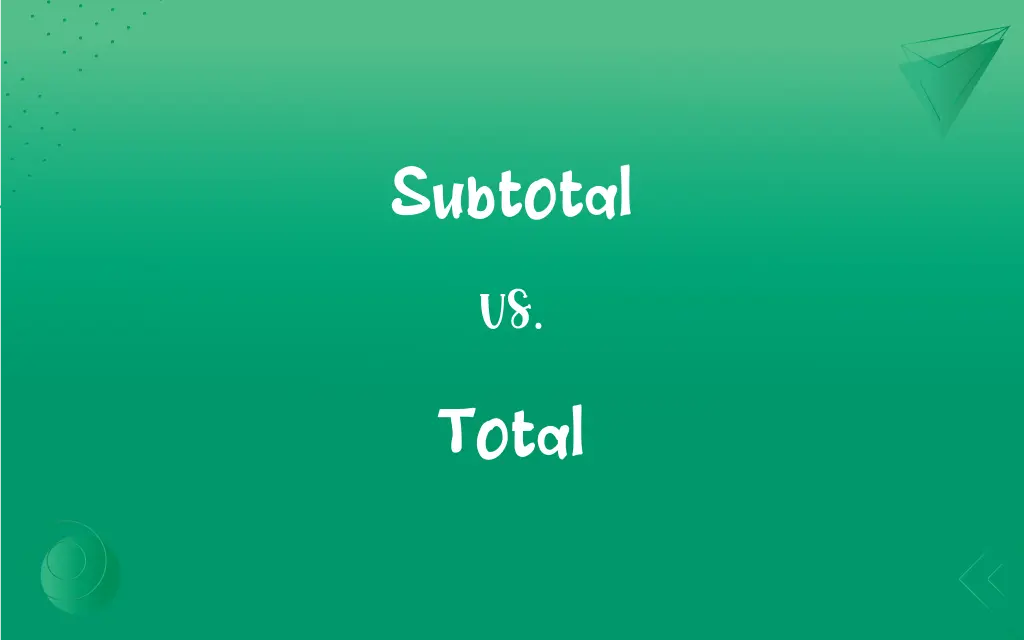Subtotal vs. Total: What's the Difference?
By Janet White || Updated on March 4, 2024
Subtotal refers to the intermediate sum of selected items or figures before all calculations are completed, whereas total represents the final sum after all additions, deductions, and adjustments have been made.

Key Differences
Subtotal and total are terms commonly used in financial transactions, accounting, and various forms of numerical analysis to differentiate between intermediate sums and the final sum, respectively.
Subtotal serves as an intermediate figure that represents the sum of a specific group of items within a larger set. It is useful for understanding the contribution of a particular category or section to the overall amount. On the other hand, the total is the comprehensive sum that includes all items, adjustments, taxes, discounts, and any other factors that affect the final amount payable or receivable. It represents the complete and final calculation in a transaction or report.
The distinction between subtotal and total is crucial for clarity in financial documentation and reporting. It ensures that all parties involved in a transaction or analysis can understand the composition of the figures involved, track financial flows, and make informed decisions based on the detailed breakdown of costs or revenues.
While subtotal provides a snapshot of part of the calculation, enabling detailed analysis and understanding of different components of the total, the total figure delivers a conclusive value. This distinction is not only important in financial transactions but also in statistical analysis, budgeting, and any scenario where cumulative figures are broken down into constituent parts for detailed examination.
Comparison Chart
Definition
An intermediate sum of selected items or figures within a larger set.
The final sum after all additions, deductions, and adjustments.
ADVERTISEMENT
Purpose
To provide clarity on the contribution of specific categories or sections before final calculations.
To represent the complete and final amount after all calculations.
Usage
Used for understanding detailed breakdowns and for intermediate calculations.
Used for indicating the final amount payable or receivable in transactions.
Inclusion
Includes sums of specific groups or categories, without final adjustments.
Includes all items, taxes, discounts, and adjustments for the final figure.
Importance
Helps in analyzing and understanding the composition of costs or revenues.
Provides the conclusive figure needed for payment, reporting, or decision-making.
Subtotal and Total Definitions
Subtotal
A subtotal is the sum of a specific group of items before final calculations.
The invoice's subtotal for hardware supplies was $500 before tax.
ADVERTISEMENT
Total
It represents the complete amount in transactions.
The total on the grocery receipt included the subtotals plus taxes.
Subtotal
Subtotals are used for clarity in financial breakdowns.
The catering quote provided a subtotal for food before adding service fees.
Total
The total is used for final reporting and decision-making.
The total revenue for the quarter was calculated after all adjustments.
Subtotal
Subtotals help in understanding expenditures by category.
The project's budget included subtotals for each department's expenses.
Total
The total provides a conclusive value for financial transactions.
The total investment needed for the startup was finalized after considering all factors.
Subtotal
The subtotal represents an intermediate figure in calculations.
After adding the service charges, the subtotal was adjusted before applying the discount.
Total
An amount obtained by addition; a sum.
Subtotal
Less than total; incomplete.
Total
The whole amount of something; the entirety
The storm damaged the total of the housing units.
Subtotal
The total of part of a series of numbers.
Total
Of, relating to, or constituting the whole amount; entire
The total population of the city.
Subtotal
To total part of (a series of numbers).
Total
Complete; utter; absolute
Total concentration.
A total effort.
A total fool.
Subtotal
To arrive at a subtotal.
Total
To determine the total of; add up
They totaled the applications at 600.
Subtotal
The total for a part of a list of numbers being summed.
Total
To equal a total of; amount to
The week's receipts totaled more than $90,000.
Subtotal
To calculate a subtotal.
Total
To wreck completely; demolish
The driver survived the crash but totaled the car.
Subtotal
Less than total; partial.
Total
To add up; amount
It totals to $25.
Subtotal
It allows for detailed analysis within a larger calculation.
The conference budget's subtotal for travel expenses highlighted the major cost areas.
Total
An amount obtained by the addition of smaller amounts.
A total of £145 was raised by the bring-and-buy stall.
Total
Sum.
The total of 4, 5 and 6 is 15.
Total
Entire; relating to the whole of something.
The total book is rubbish from start to finish.
The total number of votes cast is 3,270.
Total
(used as an intensifier) Complete; absolute.
He is a total failure.
Total
(mathematics) (of a function) Defined on all possible inputs.
The Ackermann function is one of the simplest and earliest examples of a total computable function that is not primitive recursive.
Total
(transitive) To add up; to calculate the sum of.
When we totalled the takings, we always got a different figure.
Total
To equal a total of; to amount to.
That totals seven times so far.
Total
To demolish; to wreck completely. (from total loss)
Honey, I’m OK, but I’ve totaled the car.
Total
(intransitive) To amount to; to add up to.
It totals nearly a pound.
Total
Whole; not divided; entire; full; complete; absolute; as, a total departure from the evidence; a total loss.
Total
The whole; the whole sum or amount; as, these sums added make the grand total of five millions.
Total
To bring to a total; also, to reach as a total; to amount to.
Total
To determine the total of (a set of numbers); to add; - often used with up; as, to total up the bill.
Total
To damage beyond repair; - used especially of vehicles damaged in an accident; as, he skid on an ice patch and totaled his Mercedes against a tree. From total loss.
Total
The whole amount
Total
A quantity obtained by addition
Total
Add up in number or quantity;
The bills amounted to $2,000
The bill came to $2,000
Total
Determine the sum of;
Add all the people in this town to those of the neighboring town
Total
Constituting the full quantity or extent; complete;
An entire town devastated by an earthquake
Gave full attention
A total failure
Total
Including everything;
The overall cost
The total amount owed
Total
Without conditions or limitations;
A total ban
Total
Complete in extent or degree and in every particular;
A full game
A total eclipse
A total disaster
Total
The total is the final sum after all additions and deductions.
The total cost of the renovation, including materials and labor, was $10,000.
Total
It includes everything necessary for the final figure.
The invoice's total accounted for all services rendered and applicable taxes.
FAQs
Can there be multiple subtotals in a calculation?
Yes, there can be multiple subtotals in a calculation, representing different categories or sections within the overall calculation to aid in detailed analysis.
What is a subtotal?
A subtotal is an intermediate figure that sums up selected items or figures within a larger calculation, before all adjustments and additional calculations are made.
What does the total represent?
The total represents the final amount after all items, taxes, discounts, and any other adjustments have been accounted for in a calculation or transaction.
Are subtotals and totals only used in financial contexts?
While commonly used in financial contexts, subtotals and totals are also used in statistical analysis, inventory management, and any situation requiring a detailed breakdown of figures before reaching a final sum.
Is the total always higher than the subtotal?
Not necessarily. The total can be higher or lower than the subtotal, depending on whether additional charges exceed any discounts or deductions applied to the subtotal.
Why is a subtotal important?
A subtotal is important for providing a clear breakdown of costs or revenues by category, helping in detailed analysis and understanding of financial flows before final adjustments.
How is the total calculated from the subtotal?
The total is calculated by taking the subtotal and adding any taxes, fees, or additional charges, and subtracting any discounts or deductions.
What role do subtotals play in tax calculations?
Subtotals play a crucial role in tax calculations by providing a base figure from which taxes are calculated, ensuring accuracy in the amount of tax owed or refundable.
How do subtotals and totals help in budgeting?
In budgeting, subtotals help track expenses or revenues by category, providing insight into where funds are allocated, while totals give a conclusive figure for overall budget limits or goals.
Can subtotals affect decision-making?
Yes, subtotals can significantly affect decision-making by highlighting areas of high expenditure or revenue, helping businesses and individuals make informed choices about where to allocate or reduce resources.
What is the difference between a subtotal and a gross total?
A subtotal is an intermediate figure that does not include tax or other final adjustments, whereas a gross total includes some adjustments but not deductions like discounts. The total includes all adjustments, including taxes and discounts, for the final amount.
What impact do subtotals have on fiscal analysis and forecasting?
Subtotals allow for granular analysis of fiscal data, helping in identifying trends, forecasting future performance, and making budgetary adjustments based on specific categories or segments.
How are subtotals used in tax preparation and filing?
In tax preparation and filing, subtotals are used to aggregate income, deductions, and credits by type before applying tax rates or specific tax rules, ensuring accurate calculation of taxable income and tax liability.
How can subtotals improve customer understanding of billing?
Providing subtotals on bills helps customers understand how the final amount was calculated, including the cost breakdown of services or products before taxes and other charges, enhancing transparency and trust.
Can subtotals be misleading in financial reports?
While not inherently misleading, subtotals must be clearly defined and used consistently to avoid confusion. Misplacement or misinterpretation of subtotals without proper context can lead to misunderstandings about financial data.
How do online shopping carts utilize subtotals and totals?
Online shopping carts display subtotals to show the cost of items before taxes and shipping, with the total reflecting the final amount due after all charges and discounts, aiding in transparent pricing.
In what situations are subtotals most commonly used?
Subtotals are commonly used in situations requiring a detailed financial breakdown, such as invoices, budget reports, sales analysis, and anywhere clarity on the composition of costs or revenues is needed.
Why might the total be less than the subtotal in some transactions?
The total might be less than the subtotal if discounts or rebates applied exceed any additional charges or taxes added to the subtotal, leading to a lower final amount.
How do subtotals help in analyzing sales data?
Subtotals help in analyzing sales data by grouping sales into categories (e.g., product types, regions) before applying discounts or taxes, allowing businesses to assess performance and make strategic decisions based on category-specific data.
How do software and spreadsheets use subtotals?
Software and spreadsheets use subtotals to automatically calculate intermediate sums within a dataset, facilitating quick analysis, summary reports, and organized presentation of data based on user-defined criteria.
About Author
Written by
Janet WhiteJanet White has been an esteemed writer and blogger for Difference Wiki. Holding a Master's degree in Science and Medical Journalism from the prestigious Boston University, she has consistently demonstrated her expertise and passion for her field. When she's not immersed in her work, Janet relishes her time exercising, delving into a good book, and cherishing moments with friends and family.































































